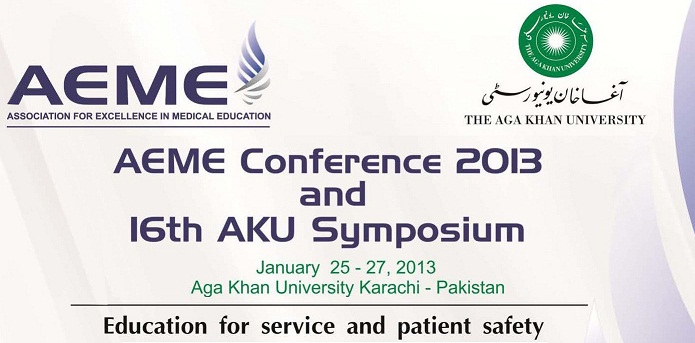Day 1 : Oral Presentations (Theme: Curriculum Innovations)
Introduction of “Patient-Centered Urdu Communication Course” in undergraduate medical education (UGME)
Location
AKU Auditorium
Start Date
26-1-2013 10:30 AM
Abstract
Background: We, at Aga Khan University Medical College (AKU-MC), observed that many students find it difficult to communicate effectively with patients in Urdu. Two obvious reasons are lack of spoken fluency in Urdu and a limited vocabulary. We introduced ‘Patient-centered Urdu Communication Course’ in first year of MBBS course. The objectives of the course are to provide students an opportunity to learn and practise Urdu communication patterns related to patients and to familiarize them with Urdu terminologies for common diseases.
Methods: This course has been developed and delivered by Curriculum Office for UGME and a faculty member from Ismaili Tariqah & Religious Education Board (ITRAB). A handout was developed in which Urdu translation of around 200 common diseases has been listed. Faculty and staff members from different departments, having good command on Urdu, were identified and asked to participate in facilitation. Students do in-groups activities to enhance effective conversation with patients in simulated settings. Facilitators help students to communicate with patients in accordance to their psychological and cultural backgrounds and give feedback.
Results: This course was first introduced in the academic year 2009-2010 and currently we are conducting it for academic year 2012-2013. Feedback from the course participants and focus group discussions with mentors showed that the course appears to have worked well in last two years. Examination & Promotion Committee has made it a must-pass activity for upcoming years. Conclusions: Courses like Urdu Communication are crucial in the context of Pakistan where English is the medium of instruction, and majority of patients do not understand the jargon of medicine. Formal and contextual teaching of Urdu communication helps students to identify their weaknesses, learn Urdu terminologies for common diseases and practice patient centered communication in Urdu.
Key words: communication skills, doctor-patient relationship, curriculum development
Introduction of “Patient-Centered Urdu Communication Course” in undergraduate medical education (UGME)
AKU Auditorium
Background: We, at Aga Khan University Medical College (AKU-MC), observed that many students find it difficult to communicate effectively with patients in Urdu. Two obvious reasons are lack of spoken fluency in Urdu and a limited vocabulary. We introduced ‘Patient-centered Urdu Communication Course’ in first year of MBBS course. The objectives of the course are to provide students an opportunity to learn and practise Urdu communication patterns related to patients and to familiarize them with Urdu terminologies for common diseases.
Methods: This course has been developed and delivered by Curriculum Office for UGME and a faculty member from Ismaili Tariqah & Religious Education Board (ITRAB). A handout was developed in which Urdu translation of around 200 common diseases has been listed. Faculty and staff members from different departments, having good command on Urdu, were identified and asked to participate in facilitation. Students do in-groups activities to enhance effective conversation with patients in simulated settings. Facilitators help students to communicate with patients in accordance to their psychological and cultural backgrounds and give feedback.
Results: This course was first introduced in the academic year 2009-2010 and currently we are conducting it for academic year 2012-2013. Feedback from the course participants and focus group discussions with mentors showed that the course appears to have worked well in last two years. Examination & Promotion Committee has made it a must-pass activity for upcoming years. Conclusions: Courses like Urdu Communication are crucial in the context of Pakistan where English is the medium of instruction, and majority of patients do not understand the jargon of medicine. Formal and contextual teaching of Urdu communication helps students to identify their weaknesses, learn Urdu terminologies for common diseases and practice patient centered communication in Urdu.
Key words: communication skills, doctor-patient relationship, curriculum development

